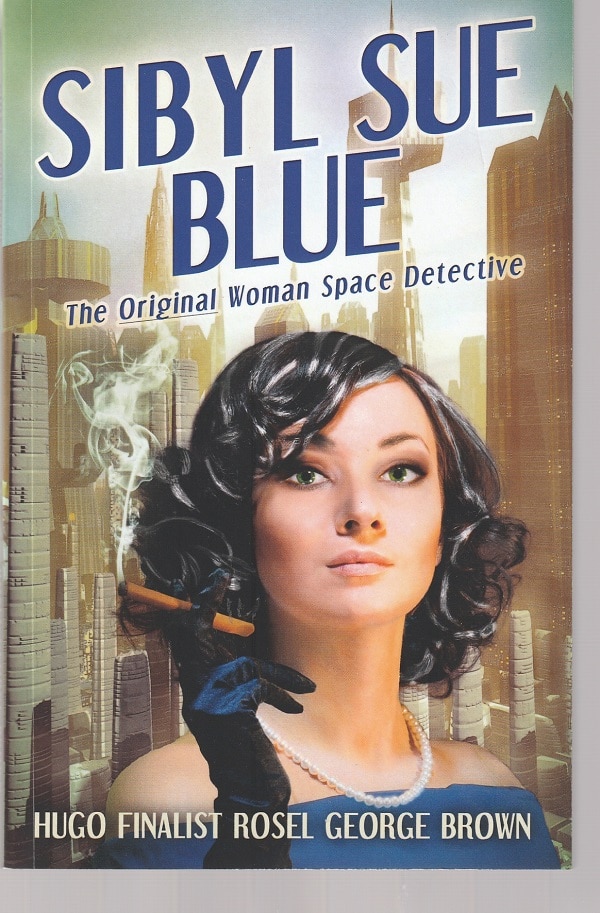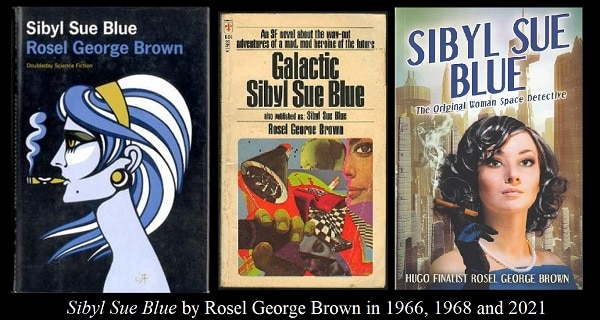Sgt. Sibyl Sue Blue of the spaceport city of Hammond is just, as one of her police colleagues says, “a little bitty girl.”

He says this after she knocks a gun from the hand of a skulking Centaurian — a humanoid extraterrestrial — and knees him “where it hurt the most and then rabbit punched him. It’s the same place for Centaurians as it is for humans.”
And she’s off on an adventure that takes her to a planet that is a single, huge, ambitious and nearly unstoppable plant — like a gargantuan weed that can destroy Earth — as she seeks to solve the odd-looking murders of several humans, seeming suicides involving the self-removal of the liver which then seems to disappear.
Sibyl Sue Blue, also known in one edition as Galactic Sibyl Sue Blue, was published in 1966 by Rosel George Brown after an apprenticeship in which 21 of her science fiction short stories found magazine homes over the previous two decades.
Judith Merril, one of the first women to be influential in science fiction, described the book in a review as “wildly entertaining” and “long overdue.” In addition, she wrote that, “under all the froth and fun and furious action, there is more acute comment on contemporary society than you are likely to find in any half dozen deadly serious social novels.” Another reviewer hoped for more fiction to come from Brown.
But, in late 1967, the author died of lymphoma, and her only other work was The Waters of Centaurus, brought into print posthumously by her husband.
Sibyl being Sibyl
Merril was right about “all the froth and fun and furious action.” And it’s due to Sibyl being Sibyl.
Indeed, Sibyl’s daughter Missy is understandably distressed when she finds out that her mother is joining an expedition to the planet where her father went missing ten years earlier. Sibyl tells her:
“I know how hard it is right now to be you. I…I’ll tell you the secret of life right now. Quick. The secret of life is for you to enjoy being you. If you can do that, everything else happens by itself.”
And that’s the novel in a nutshell.
Sibyl is a swashbuckling cop who doesn’t take any guff. She’s her own person, and she does what she wants to do to accomplish what she wants to accomplish.
She seduces one of the richest men in the world, falling in love with him in the process (sort of), in order to get a ride on his ship to that mysterious planet Radix. Even so, when the time comes to, so to speak, sever ties with him, she does so with little fanfare.

Cringe-worthy
Sibyl Sue Blue is the sort of woman who acts with the freedom and self-confidence of a man in an era when ladies weren’t supposed to be like that at all. Indeed, it would be decades before society, literature and entertainment caught up with Sibyl. You can see her granddaughters in the many super-women movies of the 21st century.
Even so, there are a goodly number of cringe-inducing moments in Brown’s novel for any modern-day person who doesn’t know what life on Earth was like more than half a century ago. For instance:
“She bathed [two injured crew members] every day and did all the cooking because Dr. Beadle [the only other non-injured person] made it plain that he did not do these menial chores.”
Argh!
Patrick T. Reardon
8.17.21
Written by : Patrick T. Reardon
For more than three decades Patrick T. Reardon was an urban affairs writer, a feature writer, a columnist, and an editor for the Chicago Tribune. In 2000 he was one of a team of 50 staff members who won a Pulitzer Prize for explanatory reporting. Now a freelance writer and poet, he has contributed chapters to several books and is the author of Faith Stripped to Its Essence. His website is https://patricktreardon.com/.
